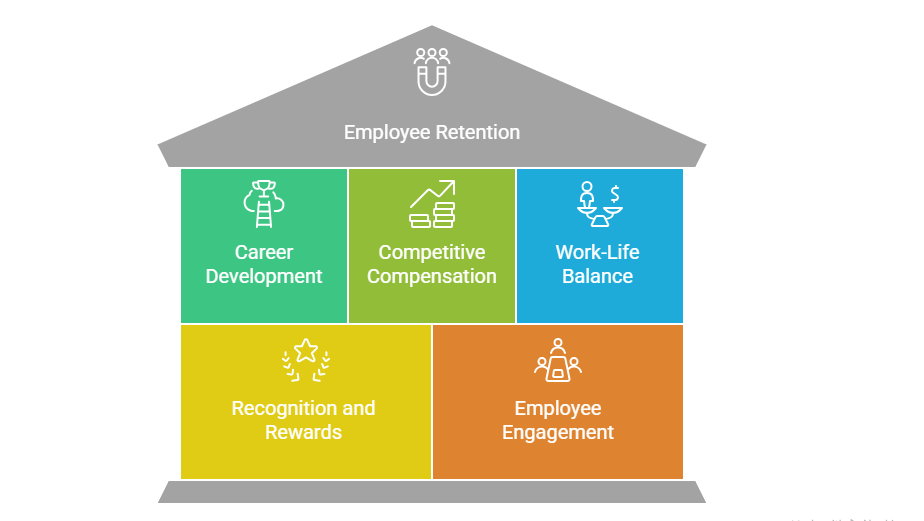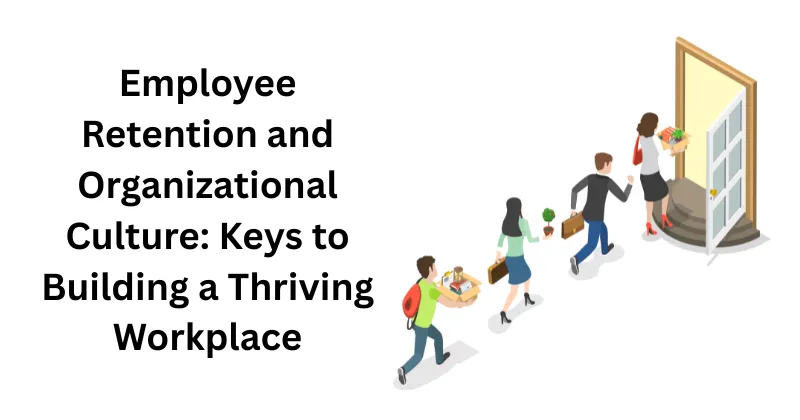Employee retention and organizational culture are critical drivers of workplace success, shaping how businesses attract, engage, and keep talent. For BBA students, mastering these concepts in Human Resource & Organisational Behaviour is essential for acing exams and excelling in HR internships. This article explores effective employee retention strategies, the elements of a strong organizational culture, and how they work together to create a productive, happy workplace. With clear examples and practical insights, this guide will help you nail this syllabus topic and prepare for a career in HR.
What Are Employee Retention and Organizational Culture?
Employee retention refers to an organization’s efforts to keep employees from leaving, reducing turnover and retaining talent. It involves strategies like rewards, career growth, and work-life balance. Organizational culture is the shared values, beliefs, and behaviors that define a workplace, influencing how employees interact and perform. Together, they create a workplace where employees feel valued and motivated, leading to workplace success.
A 2024 report by SHRM found that organizations with strong retention and culture strategies see 25% higher productivity, highlighting their importance for students and businesses.
Employee Retention Strategies
Effective employee retention strategies ensure employees stay committed and satisfied. Here are key approaches:

- Career Development Opportunities
- Offer training programs, mentorship, or clear paths to promotion to help employees grow professionally.
- Example: A sales team member attends workshops to develop leadership skills, aiming for a managerial role.
- Impact: Shows employees a future in the organization, reducing the likelihood of resignations.
- Competitive Compensation
- Provide salaries, bonuses, or incentives that align with industry standards to reward performance.
- Example: Offering a performance-based bonus to a marketing team for achieving campaign goals.
- Legal Note: Compliance with the Minimum Wages Act, 1948, ensures fair pay in India.
- Work-Life Balance Policies
- Implement flexible working hours, remote work options, or wellness programs to support personal needs.
- Example: Allowing a customer service team to work part-time from home to manage family responsibilities.
- Stat: A 2023 Economic Times article noted 60% of employees prioritize work-life balance when choosing to stay.
- Recognition and Rewards
- Acknowledge achievements through awards, certificates, or public praise to boost morale.
- Example: Honoring an employee as “Star of the Month” for outstanding project delivery.
- Impact: Creates a sense of appreciation, encouraging loyalty.
- Employee Engagement
- Foster involvement through regular feedback surveys, team-building activities, or open discussions.
- Example: Holding monthly meetings to gather a team’s input on workplace improvements.
- Benefit: Makes employees feel valued, reducing turnover.
Table: Employee Retention Strategies
| Strategy | Key Benefit | Implementation Tip | Exam Relevance |
|---|---|---|---|
| Career Development | Boosts skill growth | Offer online courses | Common in HR case studies |
| Competitive Compensation | Rewards performance | Benchmark industry salaries | Tested in retention questions |
| Work-Life Balance | Reduces stress | Introduce flexible shifts | Key for viva on employee satisfaction |
| Recognition | Enhances morale | Monthly award programs | Asked in descriptive answers |
| Engagement | Improves loyalty | Conduct team surveys | Linked to turnover reduction |
Exam Tip: Use this table to explain retention benefits in short-answer questions, linking to workplace outcomes.
Elements of a Positive Organizational Culture
A strong organizational culture creates a workplace where employees thrive. Key elements include:
- Shared Values
- Clear principles like integrity, innovation, or teamwork guide employee behavior and decisions.
- Example: A workplace prioritizing collaboration encourages employees to work together on projects.
- Impact: Aligns individual goals with organizational objectives.
- Inclusivity
- Promote diversity and equal opportunities, ensuring all employees feel respected.
- Example: Valuing every team member’s ideas during brainstorming sessions.
- Stat: A 2024 Business Standard report noted inclusive cultures boost innovation by 20%.
- Open Communication
- Encourage transparent feedback and idea-sharing to build trust.
- Example: Hosting regular forums where employees discuss workplace challenges.
- Benefit: Fosters collaboration and reduces misunderstandings.
- Collaboration
- Foster teamwork through group projects, cross-departmental tasks, or team-building activities.
- Example: Organizing team-building exercises to strengthen a project team’s bond.
- Impact: Enhances productivity and employee satisfaction.
- Adaptability
- Embrace change, such as adopting new technology or processes, to stay competitive.
- Example: Training employees to use a new software system for better efficiency.
- Legal Note: The Industrial Disputes Act, 1947, supports fair change management in India.
Table: Elements of Organizational Culture
| Element | Key Outcome | Practical Step | Exam Relevance |
|---|---|---|---|
| Shared Values | Aligns goals | Define clear mission statement | Tested in culture questions |
| Inclusivity | Boosts innovation | Conduct diversity training | Common in OB viva |
| Open Communication | Builds trust | Set up feedback channels | Asked in team dynamics |
| Collaboration | Enhances teamwork | Plan team activities | Linked to productivity |
| Adaptability | Drives efficiency | Train for new tools | Key for change management |
Exam Tip: Use this table to link culture elements to outcomes in descriptive answers.
How Retention and Culture Drive Workplace Success
Employee retention and organizational culture are interconnected pillars of workplace success:
- Culture Supports Retention
- A positive culture (e.g., inclusive, collaborative) makes employees want to stay longer.
- Example: A workplace with open feedback channels addresses employee concerns, reducing resignations.
- Impact: Saves costs on hiring and training.
- Retention Reinforces Culture
- Long-term employees uphold and strengthen cultural values, creating consistency.
- Example: Experienced team members model teamwork, inspiring new hires to follow suit.
- Benefit: Builds a cohesive work environment.
- Combined Benefits
- Together, they enhance morale, innovation, and performance across teams.
- Example: A sales team with career growth opportunities and a collaborative culture achieves higher targets.
- Stat: A 2024 People Matters study found organizations with strong culture and retention see 35% higher employee engagement.
Exam Tip: Explain this synergy in case-based questions, using generic scenarios like a team exceeding goals.
Challenges in Implementation
Building employee retention and organizational culture faces several obstacles:
- Resistance to Change
- Employees may resist cultural shifts, such as adopting inclusivity or new technology.
- Example: A team hesitates to embrace a new collaborative software.
- Solution: Provide training and communicate benefits clearly.
- Cost Constraints
- Retention strategies like bonuses or training programs require financial resources.
- Example: Limited budgets delay the launch of mentorship initiatives.
- Solution: Focus on low-cost options like recognition programs.
- Lack of Employee Awareness
- Employees may not fully understand cultural values or retention benefits.
- Example: New hires unaware of feedback mechanisms leave early.
- Solution: Conduct thorough onboarding sessions.
- Inconsistent Leadership
- Leaders who fail to model cultural values weaken retention efforts.
- Example: A manager ignoring team input harms inclusivity.
- Solution: Invest in leadership development programs.
Exam Tip: Discuss these challenges with practical solutions for viva or long-answer questions.
The Importance of Human Resource Planning in Organizational Success
Practical Applications in Business
Employee retention and organizational culture have significant real-world applications:
- Talent Retention: Retention strategies keep skilled employees, reducing recruitment expenses.
- Example: Offering flexible hours to a tech team lowers turnover rates.
- Productivity Boost: A collaborative culture drives team efficiency.
- Example: Team-building exercises improve project delivery timelines.
- Employee Satisfaction: Inclusive cultures enhance job satisfaction and loyalty.
- Example: Valuing diverse ideas in meetings boosts team morale.
- Competitive Advantage: A strong culture attracts top talent in competitive markets.
- Example: A reputation for adaptability draws skilled applicants.
Example Scenario: A retail team with mentorship programs and an open communication culture sees higher sales performance and fewer resignations.
Tips to Master Retention and Culture for Exams
To excel in Human Resource & Organisational Behaviour exams:
- Learn Key Concepts: Memorize retention strategies and culture elements, focusing on their outcomes.
- Understand Synergy: Explain how retention and culture together drive workplace success.
- Use Tables: The retention and culture tables provide quick revision points for exams.
- Check Resources: Explore SHRM for the latest HR trends.
- Prep for Vivas: Be ready to discuss how inclusivity strengthens retention efforts.
Conclusion
Employee retention and organizational culture are essential for building a thriving workplace, making them critical for BBA students in Human Resource & Organisational Behaviour. Retention strategies like career development and rewards keep talent engaged, while a culture of inclusivity and collaboration boosts morale and productivity. Together, they create workplace success, benefiting both employees and organizations. Use this guide to ace your exams, shine in internships, and prepare for a successful HR career. Dive into resources like People Matters to deepen your knowledge, and keep learning to master these concepts!
👨💼 Author: BBAProject Editorial Team
✍️ The BBAProject Editorial Team comprises business graduates and educators dedicated to creating practical, syllabus-based learning resources for BBA students.
⚠️ Please Note: Articles published on BBAProject.in are well-researched and regularly updated. However, students are advised to verify data, statistics, or references before using them for academic submissions.

